|
FAQs about Merulinid Corals
Identification
Related Articles: Merulinids, SPS
Corals,
Related FAQs: Merulinids 1, Merulinids 2, & FAQs on: Merulinid Behavior, Merulinid Compatibility, Merulinid Selection, Merulinid Systems, Merulinid Feeding, Merulinid Disease, Merulinid Reproduction/Propagation,
& Stony/True Coral, Coral System Set-Up, Coral System Lighting, Stony Coral Identification, Stony Coral Selection, Coral Placement, Foods/Feeding/Nutrition, Disease/Health, Propagation, Growing Reef Corals, Stony Coral Behavior, SPS Identification, SPS Behavior, SPS
Compatibility, SPS Selection,
SPS Systems, SPS Feeding, SPS
Disease, SPS
Reproduction,
|
[1]%20merulinid%20birds%20nest.jpg)
|
|
What is this ? Scler. ID
3/19/14
I found this coral on a colony of Zoas I received from live aquaria.
Decided to remove from the liverock and add to a frag plug. A couple
months later it's spread like crazy. I have searched everywhere and
still have no clue what it may be.... Any help would be greatly
appreciated!!
-Matt
<That pattern.... Is this Merulina? Bob Fenner>
|
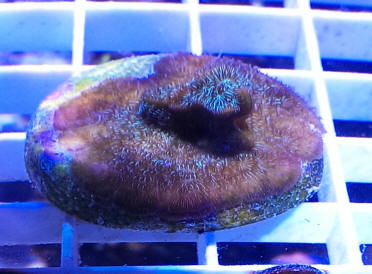 |
|
SPS identification 11/9/13
Hello Mr. F.
How are you?
<Fine; thank you>
Can you please help me identify the coral in the image? I think is a
Montipora but I am not sure. It is a beauty, 30 cm high and in order to take
best care of it, I need to know what is it.
<... The pic doesn't have enough detail, but this looks like some type of
robust Hydnophora at first glance>
I know it doesn't like too much flow, because part of it was in front of an
Vortech MP 40 and that part didn't opened the polyps anymore. So I moved the
pump a little bit and now seems ok.
Thank you,
Andrei
<Welcome. BobF>
|
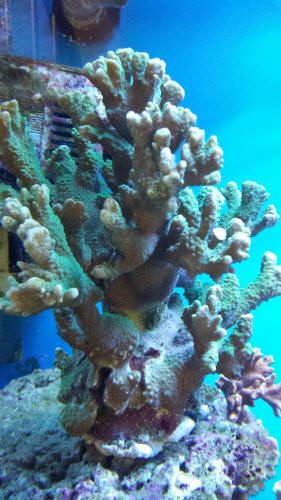 |
|
Mystery coral 1/4/13
Hi there,
<Howdy>
I have a Coral and have no idea what it is. I have had several
people look at it, and even posted it on livingreefs.com. They
suggested I try here.
<Ok>
I purchased it a week ago, the seller said it was Leptastrea.
<Mmm, nah>
When I looked that up, it looked nothing like it. Another person
suggested Galaxea,
<Nope>
but the pattern for the polyps is all wrong.
I rather like the coral, and just want to make sure I am giving it the
proper care.
Here is a picture with my Hawkfish photo bombing it.
<Heeee!>
The stony portions are purple, and the polyps are a pale bluish
white-they run a ring around stony protrusions. The
frag itself is about half inch square, on a cut stone plug.
Thanks in advance,
Amy Kantor
<Would like to see a larger, more-resolved image, but do I
detect hydnophores here? If so, my guess is on the family
Merulinidae:
http://www.wetwebmedia.com/merulinidae.htm
Bob Fenner>
|
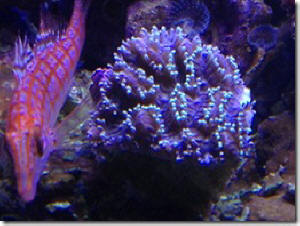 |
|
LPS identification 5/2/12
Hello Crew;
<Hello Bob>
thank you for such a wonderful web site. And for your time and dedication in
sharing this hobby with us. I hope that one of you will be able to identify
this small coral. It has a hard shell underneath the carpet type polyps.
The LFS didn't know what it was and sold it to me for five dollars. It has
been in my possession for a month now. It seems to be doing well. I also
think it moves a little or maybe gets moved by the turbo snails. Not sure on
that I have been researching the internet for weeks but cannot locate any
similar corals. So that brings me to WetWebMedia in the hope of an identity
for this guy or gal.
<Mmm, appears to be a species of Goniopora and quite possibly in poor
health. From what I can see, it appears there are 24 tentacles on each polyp
which indicate a Goniopora species. Bob may have further input.>
Thank you All
<You're welcome. James (Salty Dog)>
Bob Carter
|
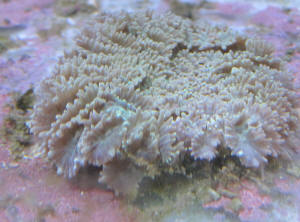 |
LPS identification 5/3/12
Thank you James;
<You're welcome.>
its no wonder there were no photos like it. If it is Goniopora it looks
pretty bad.
<There are many species of Goniopora, you may want to Google.>
However the polyps are very responsive to touch and shadows. Maybe there is
hope for it.
<Yes, do Google.>
Should I keep it for awhile or dispose of it before it dies of
completely. Your thoughts please.
<If it's responsive, I'd keep it.>
Thanks Again
<You're welcome. James (Salty Dog)>
Re LPS identification 5/3/12
OK, thanks Again
<Welcome. James (Salty Dog)>
Bob carter
Comment re. "LPS
identification 5/2/12" 5/4/12
Hi James (Salty Dog),
<Hello Alex>
I saw that you identified the coral in the above mentioned query as
Goniopora in poor health.
<It was a guess based on the number of tentacles I could make out.>
I think it might be a Hydnophora pilosa in its normal state of health.
A link for comparison:
http://www.meerwasser-lexikon.de/tiere/657_Hydnophora_pilosa.htm
<It does appear very similar.>
(which also shows how aggressive this animal can be. I have had a large
specimen for quite some time and one night it completely digested a 15 inch
Montipora…)
<Yes, I have just read how aggressive these corals can be. Thank you
for sharing and will post for others.
James (Salty Dog)>
Cheers, Alex
|
|
Coral ID help? 11/17/10
Trying to match this little dude up with photos from your site
(and others). I think its a Hydnophora, but which one?
<Looks like H. rigida to me. See here:
http://www.wetwebmedia.com/merulinidae.htm
Thanks, and have a good one.
Dan
<Or two. Bob Fenner>
Re: Coral ID help?
Thanks.
Welcome
|
|
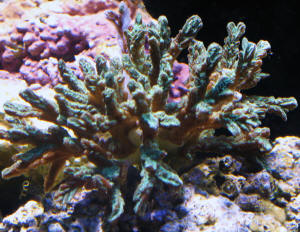
|
|
Coral ID help 9/6/2010
Hi there, thanks in advance for the assist, you guys and gals are
awesome.
<Howdy Kev>
I have this coral frag and I was told it's a Hydnophora.
However, after some research on Hydnophora and family
Merulinidae, I'm not sure. The best I could come up with is a
massive *Hydnophora exesa*. Do you guys agree or
is this something else entirely?*
<I do think this is a good guess>
*
Also, is there a good visual guide to coral identification on the
internet somewhere?
<Mmm, yes... my fave: Asira... Mmm, seems the Sara's site
is having troubles currently... Or Jake Adam's
http://coralidea.com/
Bob Fenner>
Thanks
Kevin*
|
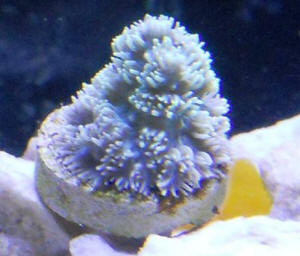 |
|
Coral Identification? -- 02/12/10
Hi Crew!
>Big J<
Any thoughts on what I might have in the attached photo?
<Mmm, maybe a Hydnophora. Read here:
http://wetwebmedia.com/merulinidae.htm>
It seems to me
like some sort of SPS based on how it has grown in the past 4
months that I've had it. What is interesting about it though
is that where I'm used to the star shaped polyps of many of
my other SPS, this has more like "worms" for what I
assume are its polyps. Reminds me somewhat of photos of
Millepora. Occasionally (usually at night) translucent tubes come
out of it in a few spots and extend to a length of perhaps 2
inches or more. Usually only a few of these, whereas the coral is
covered in the shorter wormlike and colored "polyps" as
seen in the photo.
Also, any new or interesting thoughts on getting rid of hair
algae?
<Just what's posted/archived on WWM. Need to know at least
the Division...>
I have a few "fields" of it in between some SPS and
higher in the tank where my Tomini Tang, Foxface Rabbitfish,
Pacific Blue Tang, and Flame Angel can't seem to get to it. I
have a Sally Lightfoot, a few random snails, and a couple of
Emerald Crabs, but none of these seem to be taking to the fields
of hair algae. Nitrates, Nitrites, Ammonia and Phosphates are all
zero. Hardness is around 6/7. Calcium is up around 500.
<[Mg]?>
Temp is 77 and salinity is 1.024. I use RO water and have not
been overfeeding (from what I can tell). The hair algae I'm
most worried about is the very thick bush of it growing in the
middle of some SPS.
Thanks in advance,
Jon Hoover
<Keep reading. Bob Fenner>
|
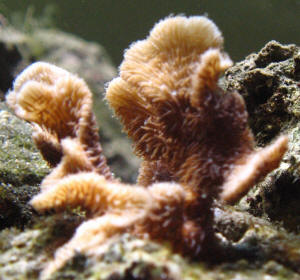 |
|
Merulina Or Platygyra Coral ID 11/23/09
Hello crew,
<Hi Paul>
This coral was labeled as a Merulina at my LFS. Every picture
I've seen of a Merulina looked more like a plating coral or
very thin with ruffles. This one is very thick. It is about
1/2" thick in spots. There were other frags of the same
thing that were at least an inch thick. I've been wanting a
Platygyra for a long time but I've never been able to find
one so I was hoping it was a mislabeled Platygyra. After reading
about Merulina and
Platygyra I decided to go ahead and purchase it. I'd like
help in identifying this specimen so I can better place it. If it
is a Merulina I'll put it on a rock higher in my tank. If it
is a Platygyra I'll keep it
on the sand. I've only had it for two nights and so far I
have not seen any sweeper tentacles. I even looked at like 3:00
am to double check.
<It appears to me you have a Merulina ampliata coral.
Bob may have a more accurate description, and if so, will input
here.>
Any thoughts on what this may actually be?
Thanks
<You're welcome. James (Salty Dog)>
Paul G.
|
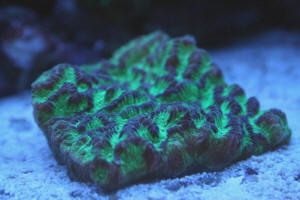 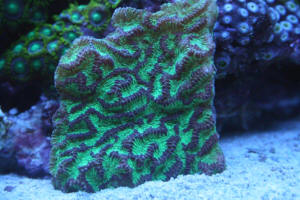 |
|
Coral ID - Catalaphyllia jardinei or not Catalaphyllia
jardinei? 4/29/09
Gentlemen!
<Mmm, have sent to SaraM for her better analysis>
Please find attached a few pictures of a species that I think may
be Catalaphyllia jardinei. I am however seeking your view on its
identification.
<Mmm... might be, but I don't think so>
The block of heads is circular with a diameter of 2 inches. The
heads are very close together and have individual heads with
diameters of 1/3 of an inch. The discs are all uniformly bright
green and the tentacles are grey to white in colour. The tentacle
tips are white under my lighting conditions.
There is a sharp septa between each head, which is only visible
when the discs are very retracted or out of the water.
This species is placed about 3 inches under the water
surface.
<Not the habitat of Catalaphyllia...>
The light is a combination of 10,000k VHO (2 x 24W) and white and
actinic LEDs. Water circulation is strong for the size of the
tank, but does not hit the species directly. Water quality is
pristine (dixit my tests) with regular water changes and
overskimmed with ozone. The species had been thriving in my tank
for over 6 months, not being specifically fed,
<Needs to be>
but grabbing a Mysid or Artemia shrimp on occasion.
Your help in identifying the species is greatly appreciated!
Thank you &
Best regards,
Tim
<Appears to be a starved Duncanopsammia axifuga to me more
than anything...
I'd be reading re its needs, meeting them. Bob Fenner>
|
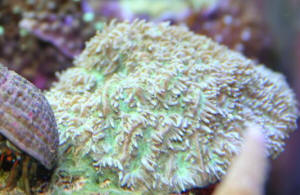 |
Re: Coral ID - Catalaphyllia
jardinei or not Catalaphyllia 4/29/09
jardinei?
Hi Bob,
<Tim>
Thank you for your reply. However, my expectation is for
Duncanopsammia axifuga to have stem/trunk where each of the heads
individually attaches, like hammerheads.
<You are correct. Both are meandroid in morphology>
This is not the case with the species in my tank: every head is
closely attached to the other and only separated by a sharp septum,
and the coral attaches directly to the rock.
<Oh! Sorry re... Is not obvious to me in the images>
But here again, I am a total beginner in coral taxonomy!
The other comment that I would make is that the species is very
high in the tank because that is where I chose to put it - and it
does seem to be faring quite well so far. Anyway, I will do more
research into Duncanopsammia axifuga.
Thank you &
Best regards,
Tim
<Let's wait on SaraM's better experience here. In the
meanwhile, If you can send along a larger image (1 mb let's
say) better resolved... perhaps taken from the surface down... with
the pumps shut off temporarily. Bob Fenner> |
|
Re: Coral ID - Catalaphyllia jardinei or not
Catalaphyllia jardinei? Sara M and Jake Adams input --
4/29/09
Hi Bob,
<Tim>
Thank you for your reply. However, my expectation is for
Duncanopsammia axifuga to have stem/trunk where each of the heads
individually attaches, like hammerheads.
<You are correct. Both are meandroid in morphology>
<<Hmm... I don't think this is a Duncan, but I do agree
with Bob that it does appear meandroid. Maybe a Platygyra
sp.?>>
This is not the case with the species in my tank: every head is
closely attached to the other and only separated by a sharp
septum, and the coral attaches directly to the rock.
<Oh! Sorry re... Is not obvious to me in the images>
But here again, I am a total beginner in coral taxonomy! The
other comment that I would make is that the species is very high
in the tank because that is where I chose to put it - and it does
seem to be faring quite well so far. Anyway, I will do more
research into Duncanopsammia axifuga.
Thank you &
Best regards,
Tim
<Let's wait on SaraM's better experience here.>
<<Ha. I'm a "beginner" in coral taxonomy
myself... but I think better pictures (ones of the coral
completely retracted, showing the skeleton better), would be
helpful. Till then, my "best guess" is Platygyra sp. If
only I had my Veron books handy here... bunk!>>
<In the meanwhile, If you can send along a larger image (1 mb
let's say)
better resolved... perhaps taken from the surface down... with
the pumps shut off temporarily. Bob Fenner>
<<Ditto. Sara M.>>
Ok... forget what I just said. I just asked Jake Adams for
help. He says it's a Hydnophora pilosa... and unless pics of
the skeleton show any different, I have to agree with him.
Cheers,
Sara M.
Re: Coral ID - Catalaphyllia jardinei or not
Catalaphyllia jardinei? -- 4/29/09
PIC4
<Tim, please see my last e-mail. You absolutely must resize
your images to ~500 KB. I've had to delete your original
images -- all of them -- because they're blocking our 10 MB
e-mail allowance. In doing so, they're bouncing back other
people's messages, which isn't fair. Resize your images,
and then send them again. We do specifically ask for this from
everyone who writes, as you'll see on the page where you got
the Crew e-mail address.
Cheers, Neale.>
Re: Coral ID - Catalaphyllia jardinei or not
Catalaphyllia jardinei? -- 4/29/09
Apologies for this,
I sent the pics in large format as requested by Bob in his
earlier email,
<<This is so. Sorry, I should have asked for just one
image... or had you send them to my personal email... which you
eventually did. RMF>>
but will get them resent to you in a smaller format ASAP.
Best
Tim
<Hi Tim, one big image isn't so bad, but eight of them,
each over 4 MB
each, simply blocks everything else getting to us. For screen
work (as
opposed to print) then 72-96 dpi is fine, and resized to 640 x
480 or 800 x
600 should be ample. If all else fails, crop away everything that
isn't
relevant. Thanks for understanding. Cheers, Neale.>
|
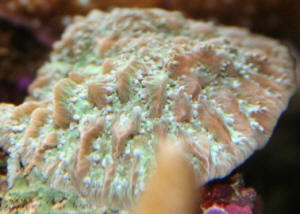 |
Re: Coral ID - Catalaphyllia
jardinei or not Catalaphyllia jardinei? -- 4/30/09
I went to look at pics of H pilosa, and it does look very
similar
(http://www.meerwasser-lexikon.de/tiere/657_Hydnophora_pilosa.htm).
In my situation, it is an encrusting type of LPS.
I am currently not in a position to send resized pics now, but will
do so at the earliest opportunity.
Best regards,
Tim
<And you. BobF>
Re: Coral ID - Catalaphyllia jardinei or not Catalaphyllia
jardinei? -- 4/30/09
Resized pics attached. reasonably sized...
Best
Tim
<Ah yes... I clearly see the skeletal hydnophores here. Bob
Fenner> |
|
Coral ID 8/18/08 Hi Again I am not really
sure what I have here. it is brilliant green with small polyps on
it. I found it in the discount tank at my LFS. It looked healthy
so I brought it home. Also, it is not attached to any sort of
base. Do you think I should attach it to something? <Likely
unnecessary... will attach itself here if this setting is stable
physically. However, there is likely to be trouble twixt the
Xeniid and Euphylliid visible in the upper left and this
Merulinid in time... I'd be reading on WWM re Cnidarian
compatibility> If so should the obvious end where it was
broken/cut off be the part glued down? Photo attached. Thanks
again Jim <A Hydnophora species... read here:
http://wetwebmedia.com/merulinidae.htm and the linked files
above. Bob Fenner>
|
|
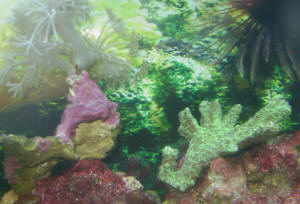
|
| Coral ID 9/22/03 Hi crew; <howdy> I
am trying to id this coral but not having a lot of luck. I'm
thinking Pagoda or Merulina or Pachyseris but I'm not sure.
<its tough to say... the shot is distant and the polyp structure
is not clear/close... but it does resemble Mycedium or Oxypora.
Definitely not pagoda (Turbinaria) or Pachyseris> It is roughly
9" x 6". Small polyps. Here's a pic. <best
regards, Anthony> |
|
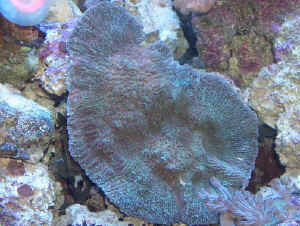
|
| Need Coral Id - 9/23/03 Anthony, thanks for
the stab. I read up on Mycedium & Oxypora and neither fit this
coral very well. I inferred from you reply that a close up of the
polyps might help. Here you go. Thanks again. Mark Vacca <quite
correct... and it does the trick. You have a nifty plating (less
common) Hydnophora species. If you have any doubts, please refer to
the works of Charlie Veron (the newer volumes if possible). Kind
regards, Anthony> |

|
|
Coral Question Follow Up-Alleged Merulina Sorry forgot to
send picture. Here it is. You also said to buy Eric
Bornemann's book "Aquarium Corals." Where can I
order it. Thanks again! <I reviewed your picture with several
friends and our general consensus is this is an octocoral,
possibly of the genera Sinularia or Nephthea. Eric
Bornemann's book is available at various aquarium e-tailers
or online bookstores. -Steven Pro>
Coral Question The LFS told me the name of this coral
was Merulina. Is this correct? If not what is the correct name?
<I don't mean to be rude, but how in the world would I
know. You have not sent a picture or even given a
description.> I have some mushrooms, pulsing Xenia, and this
piece in my 55 gallon tank along with a couple of fish. I do a
20% water change every 2 weeks and add iodine at about 4 drops
per day. Do I need to add anything else to the tank? <I
strongly urge you to buy Eric Bornemann's book "Aquarium
Corals." It will permit you to properly identify your coral
and will give you care information.> pH 8.4 Ammonia 0 Nitrite
0 Nitrate 0 Calcium 500ppm Phosphate 0.05 alkalinity 11.2 dKH or
4.0 mEq/l <The values given are all good. -Steven Pro>
|
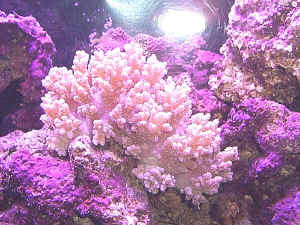 |
Coral Identification: Hydnophora 2/24/07 Hi,
<Hello Iain, Mich with you tonight.> First of all many thanks
for your website - it's a real oracle of useful information.
<Glad you think so!> My reason for writing is for a Coral ID
(see attached photo and film). <Got the photo, but was unable to
open the movie.> I bought the coral in one of my local shops (in
the UK) and they said that someone has brought it in as it had
become too large. They suggested that it is a Pocillopora but after
consulting several books, websites etc I'm not so sure as I
haven't found anything that seems similar. <Mmm, don't
think it's a Pocillopora.> It's skeleton, is white,
branching and very fragile but most of the time the polyps are out
so it's hard to see. The polyps extend 8 to 10mm during the day
and come out to the point of making the coral look like it's
been veiled in a light velvet cloth. It looks great and is growing
well but I've never seen an example of it before or since. Any
ideas ? <I believe it is a Hydnophora, also known as a velvet
horn coral. More here: http://www.wetwebmedia.com/merulinidae.htm > Many
thanks,
Iain |
|
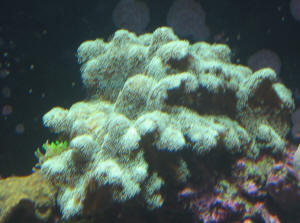
|
|
Id...Possibly Merulina ampliata -- 07/03/07 I can't
find the following in any of my books, any ideas? <Hi Brian, I
actually replied to this last night on your web site after
listening to Bob's pod cast, which was quite good by the way!
I tried to post this response but the site only allowed 300
characters. So I sent the second response.>
http://bp0.blogger.com/_Saa3csugMNM/RogAXQq9gGI/AAAAAAAAABk/mJwEj4Tqbzs/s1600-h/2007+Jul+02+004.JPG
<Greeting! Mich here from www.wetwebmedia.com> Anyone know
what type of coral this is? <Hard to tell from just one
picture. My best guess is Merulina ampliata> I checked all my
books and cannot identify it. <I am glad to read that you have
reference books! Good for you, and the creatures for which you
care!> I was a bad reefkeeper and bought it without being sure
what it was. <Not a good practice or the actions of a
conscientious aquarist. 40 lashes with a wet noodle for you!>
I highly recommend not doing this. <Me too!> Do your
research ahead of time. <Sage advise! Life to you! Michelle
Lemech> ===== Greeting! Mich here from www.wetwebmedia.com It
is difficult to tell from just one picture. My best guess is
coral may be Merulina ampliata. A little more info here:
http://www.wetwebmedia.com/merulinidae.htm Hope that helps.
Michelle Lemech
Id...Possibly Merulina ampliata 7/4/07 <Hi Brian,
Mich here.> Hmm...I looked at some pictures of the Merulina,
looks different. <Could be. Multiple growth forms are
possible, often within the same colony. Some pic's I thought
resembled yours:
http://www.aquarium-design.fr/Img/ImgTelecharge/Pt/1192.jpg
http://www.meerwasser-lexikon.de/images/1375.jpg
http://www.mailordercorals.com/displayPict.asp?cartID=1154
http://www.reefaholics.org/Sale/reefaholicsimages/images/PIC00088.JPG
http://www.atlantisaquarium.net/images/merilina.jpg.JPG The
corallites in this species tend to form ridges and valleys which
radiate from the center, which is why I though this genus was a
possibility.> I did stumble across Agaricia agaricites. Could
that be it? <Unlikely, Agaricia is an Atlantic species and
generally not available in the trade. Initially, I was think this
might be part of the Family Agaricidae, along the lines of a
Pachyseris, but the ridges and valleys tend to be more
concentric. It is difficult to identify a coral by one photo
alone, and for some corals it is outright impossible without
skeletal examination. So perhaps it is a Merulina, but it may be
something else too. Wish I could be more helpful,
Mich>
|
|
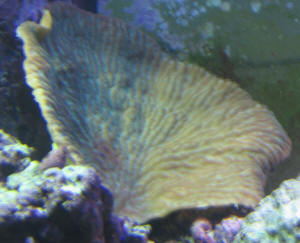
|
| Coral Identification 2/2/08 First off
I just want to say I love the site, it has helped me lots and lots.
A couple weeks ago a friend gave me a couple pieces of coral that
he no longer wanted. I thought they would go perfect in my 8g. Any
info on this piece of coral will be appreciated. <... looks like
a Hydnophora species to me...> The tank has been going for
almost a year now with no major problems. Over the tank there is a
70w viper clamp. 15lbs of LR, about a 5 inch live sand bed, 2 small
Turbos, 1 small cinnamon clown, 1 watchman goby, 1 peppermint
shrimp, 4 blue leg hermits, Cladiella sp, 1 green frogspawn, a
small clove polyps, small blue maxima and a couple of feather
dusters. <Read here: http://www.wetwebmedia.com/merulinidae.htm
and the linked files BobF> |
|
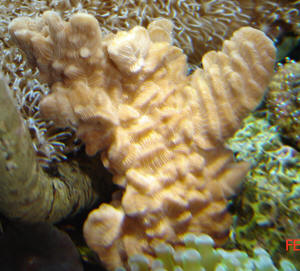
|
| help with coral, ID, lambda.... 3/6/08 Hi
Crew! Donna here needing help again. A local reefer gave me a frag
of this coral about 4 months ago. She told me it was a Pink
Birdsnest <... a Poritid? Mmm, no... Looks more like a
Hydnophora species; a Merulinid...> and she had it under PC
lighting so I thought it would be okay in my tank. A 20L with PC
lights. I put it pretty close to the top. It was doing fine all
this time and then I decided to change my lights. It was under 130W
PC and I just got the Hagen Glo T5 HO 2X29W one actinic one
daylight. I did this 4 days ago and now the coral looks like this.
Am I correct in assuming the light is too strong? I moved it lower
in the tank for now until I receive your response. Thank you in
advance! Donna P.S. the pictures are reversed I couldn't figure
out how to get them in the proper order...Sorry <Mmm, I would
borrow (check with the stores about, or the local marine/reef club)
a PAR meter... Too "guessing" to gauge how much useful
light/change otherwise here. I would in the meanwhile use a bit of
shading material as discussed here: Bob Fenner> |
|
[1]%20merulinid%20birds%20nest.jpg) 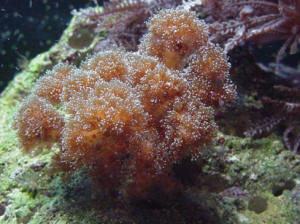
|
|
|

